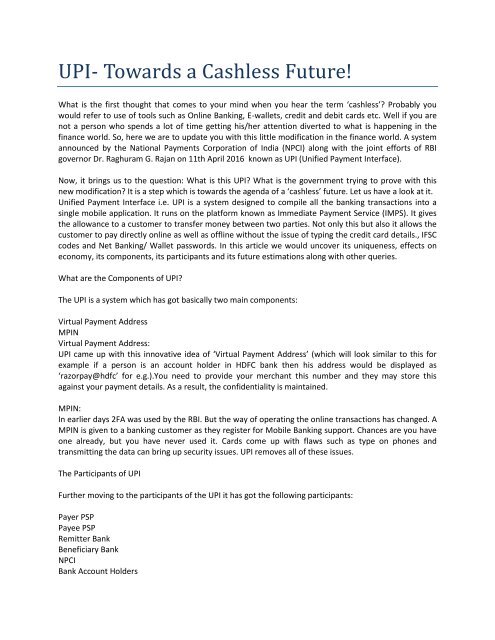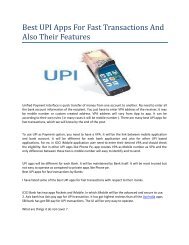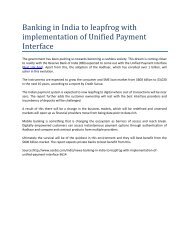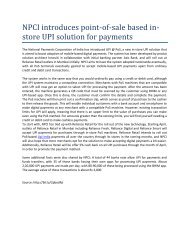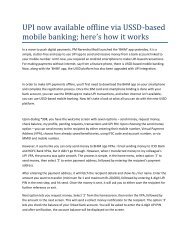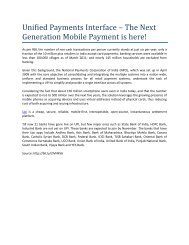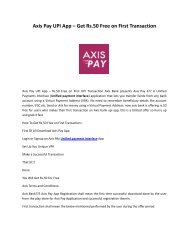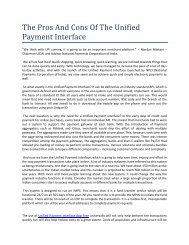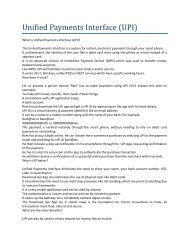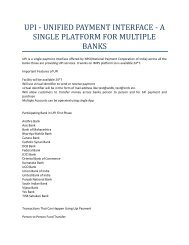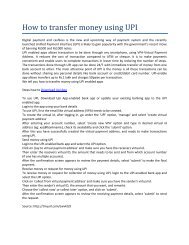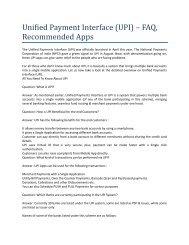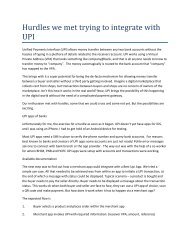UPI- Towards a Cashless Future!
Create successful ePaper yourself
Turn your PDF publications into a flip-book with our unique Google optimized e-Paper software.
<strong>UPI</strong>- <strong>Towards</strong> a <strong>Cashless</strong> <strong>Future</strong>!<br />
What is the first thought that comes to your mind when you hear the term ‘cashless’? Probably you<br />
would refer to use of tools such as Online Banking, E-wallets, credit and debit cards etc. Well if you are<br />
not a person who spends a lot of time getting his/her attention diverted to what is happening in the<br />
finance world. So, here we are to update you with this little modification in the finance world. A system<br />
announced by the National Payments Corporation of India (NPCI) along with the joint efforts of RBI<br />
governor Dr. Raghuram G. Rajan on 11th April 2016 known as <strong>UPI</strong> (Unified Payment Interface).<br />
Now, it brings us to the question: What is this <strong>UPI</strong>? What is the government trying to prove with this<br />
new modification? It is a step which is towards the agenda of a ‘cashless’ future. Let us have a look at it.<br />
Unified Payment Interface i.e. <strong>UPI</strong> is a system designed to compile all the banking transactions into a<br />
single mobile application. It runs on the platform known as Immediate Payment Service (IMPS). It gives<br />
the allowance to a customer to transfer money between two parties. Not only this but also it allows the<br />
customer to pay directly online as well as offline without the issue of typing the credit card details., IFSC<br />
codes and Net Banking/ Wallet passwords. In this article we would uncover its uniqueness, effects on<br />
economy, its components, its participants and its future estimations along with other queries.<br />
What are the Components of <strong>UPI</strong>?<br />
The <strong>UPI</strong> is a system which has got basically two main components:<br />
Virtual Payment Address<br />
MPIN<br />
Virtual Payment Address:<br />
<strong>UPI</strong> came up with this innovative idea of ‘Virtual Payment Address’ (which will look similar to this for<br />
example if a person is an account holder in HDFC bank then his address would be displayed as<br />
‘razorpay@hdfc’ for e.g.).You need to provide your merchant this number and they may store this<br />
against your payment details. As a result, the confidentiality is maintained.<br />
MPIN:<br />
In earlier days 2FA was used by the RBI. But the way of operating the online transactions has changed. A<br />
MPIN is given to a banking customer as they register for Mobile Banking support. Chances are you have<br />
one already, but you have never used it. Cards come up with flaws such as type on phones and<br />
transmitting the data can bring up security issues. <strong>UPI</strong> removes all of these issues.<br />
The Participants of <strong>UPI</strong><br />
Further moving to the participants of the <strong>UPI</strong> it has got the following participants:<br />
Payer PSP<br />
Payee PSP<br />
Remitter Bank<br />
Beneficiary Bank<br />
NPCI<br />
Bank Account Holders
Merchants<br />
Many of you might not know what are PSP and NPCI. Let’s have a look.<br />
What is PSP?<br />
In current times, <strong>UPI</strong> provides all banks to be registered as a Payment Service Provider (PSP). This has a<br />
clear inference that they can run their bank accounts and further include the e-wallets too.<br />
What is NPCI?<br />
NPCI is the abbreviated form of National Payment Corporations of India. They run into a lot of the<br />
payment infrastructure of India, including the issue of RuPay Cards and also making sure that you can<br />
easily withdraw money from any of the ATM’s irrespective of the bank account you hold.<br />
Also to remove further queries let us shower light on the part which is mostly asked consumer<br />
questions.<br />
What is the Per Transaction Limit?<br />
The per transaction limit in the <strong>UPI</strong> is INR 100,000.<br />
What kinds of transactions are included in the <strong>UPI</strong>?<br />
Merchant payments, remittances, bills payments alongside other transactions.<br />
Which banks are included in the <strong>UPI</strong>?<br />
The <strong>UPI</strong> has a tie up of 19 banks in India including Andhra Bank, Axis Bank, Bank of Maharashtra,<br />
Bhartiya Mahila Bank, Canara Bank, Catholic Syrain Bank, DCB Bank, Federal Bank, ICICI Bank, TJSB<br />
Sahakari Bank, Oriental Bank of Commerce, South Indian Bank and Yes Bank.<br />
How does the <strong>UPI</strong> work?<br />
User downloads the application from the App Store, Banks Website.<br />
User creates his/her profile by entering details like name, virtual ID (payment address), password etc.<br />
User goes to the ‘Add/Link/Manage Bank Account’ options and links the bank account number with the<br />
virtual ID.<br />
User selects the bank account from which the transaction needs to be initiated.<br />
Then he clicks on the below options<br />
Mobile Banking Registration/Generate MPIN<br />
Change M-PIN<br />
Mobile Banking Registration/ Generate M-PIN:<br />
User receives a OTP from the issuer bank on his mobile number<br />
User provides with his/her 6 digit debit card number and expiry date<br />
Then the user provides the OTP along with his/her preferred numeric M-PIN and clicks on submit<br />
Change M-PIN:<br />
User submits the old M-PIN and preferred new M-Pin and clicks on submit.<br />
He/she receives a confirmation notification of success and failure.<br />
Effects of <strong>UPI</strong> on the Indian Economy<br />
Benefits for Banks:
Single click two factor authentication<br />
Universal app for transaction<br />
Leveraging existing infrastructure<br />
Safer, secured and innovative<br />
Payment basis single/unique identifier<br />
Enable seamless merchant transactions<br />
Benefits for End Customers:<br />
Round the clock availability<br />
Single application for accessing different bank accounts<br />
Use of virtual ID is more secure, no credential sharing<br />
Single click authentication<br />
Raise complaint from mobile app directly.<br />
Benefits for Merchants:<br />
Seamless fund collection from customers- simple identifiers<br />
No risk of storing customers’ virtual address like in cards<br />
Tap customers not having debit/credit cards<br />
Suitable for e-commerce and m- commerce transactions<br />
Resolves the COD collection problem<br />
Single click 2FA facility to the customer seamless PULL<br />
In app payments (IAP)<br />
Apart from all of this let us look at what is the thing that is making the <strong>UPI</strong> so unique in its own way.<br />
USP’s of <strong>UPI</strong><br />
Immediate money transfer through mobile device around the clock 24*7 and 365 days<br />
Single mobile application for accessing different bank accounts<br />
Single click 2 factor authentication- aligned with the regulatory guidelines, yet provides for a very strong<br />
feature of seamless single click payment.<br />
Virtual address of a customer for PULL and PUSH provides incremental security with the customer not<br />
required to enter the details such as Card No, Account number, IFSC etc.<br />
Bill sharing with friends<br />
Best answer for COD issues, running into the ATM and getting the same amount out of the ATM<br />
Merchant payment with single application or In-app payments<br />
Scheduling PULL and PUSH payments for various purposes<br />
Utility Bill Payments, over the counter payments, Barcode (scan and based) Payments<br />
Donations, Collections, Disbursements Scalable<br />
Raising complaint from mobile app directly<br />
Now, we have got a deeper picture of what is Upi App Download all about and what is the working for<br />
now let’s estimate about its success in future. On hearing about the future the first question that comes<br />
into our mind is:<br />
What will happen to the mobile wallets?<br />
For now, wallets are not included in the <strong>UPI</strong> at all which means it is just a cross bank transfer medium.<br />
Hopefully, a lot of merchants will start accepting payments through <strong>UPI</strong> instead of using the wallets we
currently have. Also, the big players like PayTM won’t have any affects but the minor players in the<br />
market can face issues players like Freecharge, Mobikwick, Oxigen and Citrus Pay.<br />
The other effects in the future that can be estimated are as follows:<br />
The public sector banks are likely to face the trouble as they are not adaptive to the new technologies<br />
emerging in the market of digital payment portals.<br />
The study of Boston Consulting Group and Google shows that the total digital payments in India are<br />
about to rise in the near future about a factor of 10 by 2020 and also by 2023 it is estimated the digital<br />
transactions will overtake the cash transactions.<br />
It also gives us the insight on the number of wallet users have surpassed the number of online banking<br />
users. Also it shows, the number of wallet users is three times the number of credit card users.<br />
Most people would be awaited to look at the opportunities presented by the bank as the small business<br />
will find it difficult to obtain a credit card but for them borrowing a loan will be made easier.<br />
As the transactions are digitally recorded the chances are people won’t be able to hide money resulting<br />
into the ample amount of tax collections. This will further drop down the rates of the taxes in the future.<br />
It will also change the mindset of the people towards the risk and investments<br />
According to RBI, the 18% of country’s GDP is cash flow in the economy, so for the <strong>UPI</strong> to turn into<br />
success the main focus should be the mobile penetration in the economy.<br />
Source: http://bit.ly/2nuySKB


